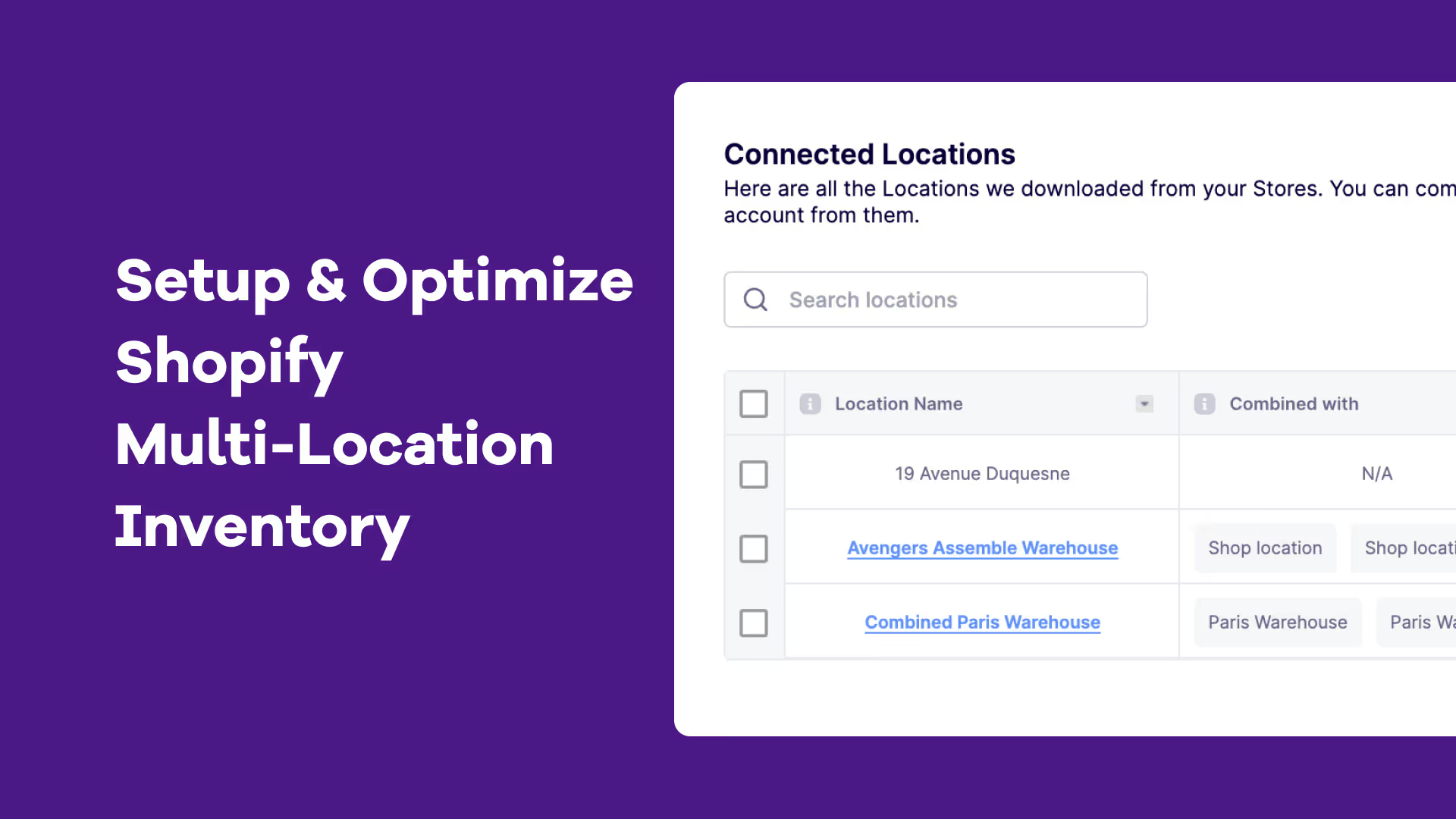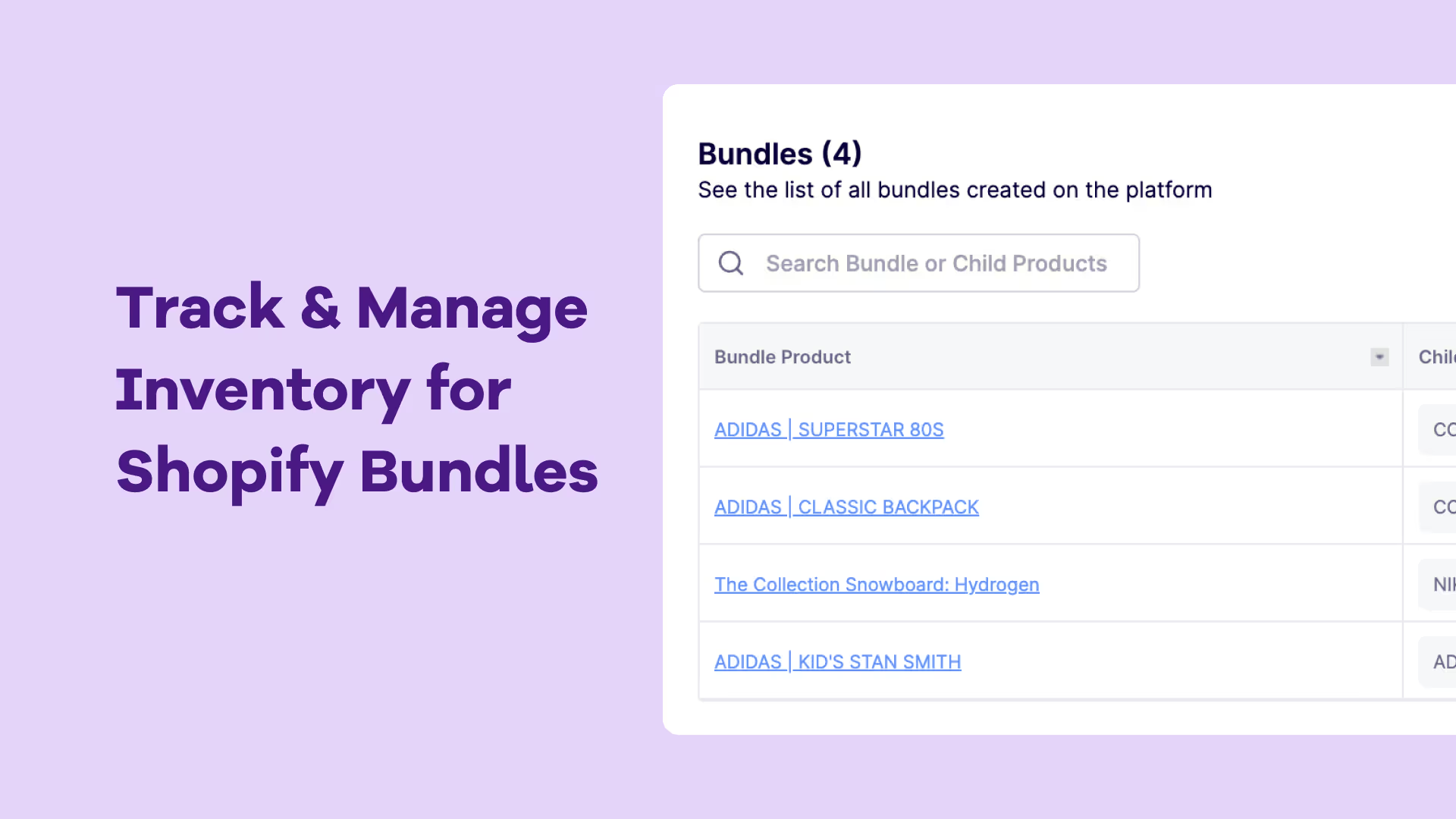What is Shopify Inventory Management?
Inventory management is the process of organizing and controlling the flow of goods within a business. It involves tracking movement of goods and materials, monitoring inventory turnover, and optimizing replenishment. Inventory management aims to minimize the cost of holding all your inventory while maintaining consistent stock levels.
Effective inventory management helps businesses maintain consistent stock levels and get products into customers’ hands faster.
Setting Up Inventory Management in Shopify
Before diving into inventory management strategies, ensure your products and inventory are properly set up within Shopify. Here's a quick guide:
Step 1: Activate inventory tracking
- Log in to your Shopify admin
- Navigate to "Products" and select a specific product
- Scroll down to the "Inventory" section
- Enable the "Track quantity" option. This allows Shopify to monitor the available quantity for each product or variant
- You can even view the history of inventory adjustments by clicking on "Adjustment History"
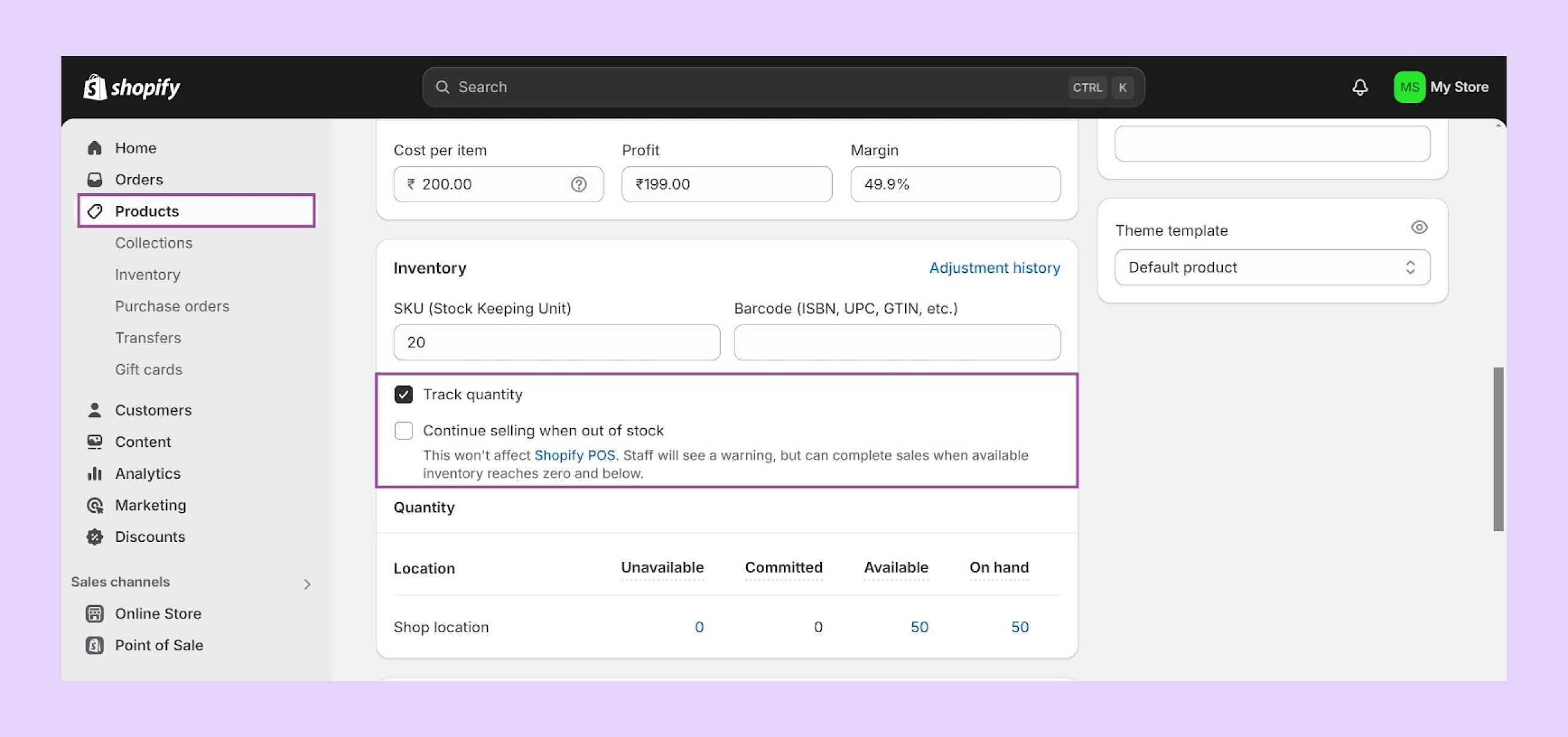
Step 2: Choose your inventory policy
- Select "Continue selling when out of stock" (It's Ideal for products with reliable restocking or for pre-orders.)
Step 3: Define product variants (if applicable)
- Products with multiple variations (size, color, etc.) require variant creation
- Access the "Variants" section within your product listing
- Create individual variants for each option, enabling separate stock tracking
Also Read: Shopify Variant Inventory Tracker: Automate to Reduce Manual Oversight

Step 4: Initial inventory entry
- Set initial stock levels for each product or variant
- Locate the "Inventory" section of your product listing
- Enter the starting quantity for each product or variant
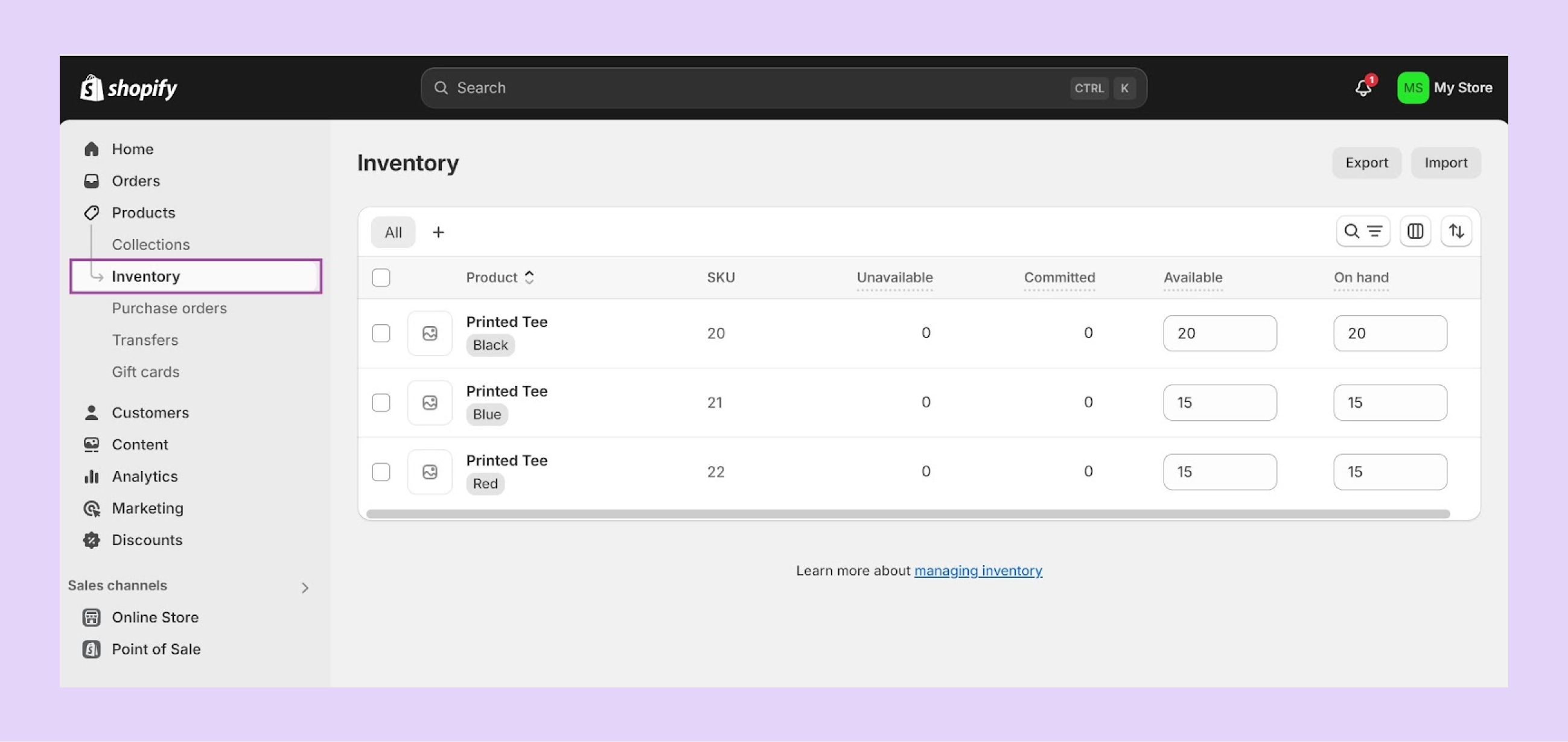
1. Inventory Tracking
Tracking inventory as it moves through the supply chain is crucial for businesses of all sizes. For startups, especially those scaling quickly, inventory management for startups often begins with simple spreadsheets but this approach breaks down fast as product lines expand.
However manual tracking becomes increasingly challenging as businesses grow and product ranges expand.The complexity of managing multiple SKUs, and variants, and accounting for returns and exchanges can quickly turn inventory tracking into a daunting task.
Effective inventory tracking is essential for successful inventory management.
Beyond the financial implications of excess stock or stockouts, poor inventory management can severely impact customer satisfaction. In the impulse-driven DTC market, an "out of stock" message can lead to lost sales and damage the brand's reputation.
As seen in the previous section, Shopify allows users to “track quantities” but its outdated approach makes its inbuilt features a parallel step from managing spreadsheets. Each SKU and product variant needs to be updated individually in Shopify.
Dealing with a large catalog can quickly become a mammoth task. Businesses are increasingly turning to AI-powered inventory tracking tools like Prediko to address these challenges and maintain optimal inventory levels.
2. Inventory Sync
Managing multiple stores becomes significantly more complex when inventory data isn't centralized. Each store operates independently, with varying demand based on factors like region, seasonality, and local trends.
Without a unified view of inventory levels, it's easy to overstock in one location while experiencing shortages in another. This can lead to increased operational costs, lost sales, and dissatisfied customers.
Businesses looking to streamline stock movement between locations should implement a centralized system for Shopify inventory transfer, enabling accurate, real-time adjustments that align with regional demand
To optimize inventory management across multiple stores, businesses need a centralized dashboard to aggregate data and track stock levels in real time. This enables efficient allocation of inventory to where it's needed most, reducing the risk of stockouts and overstock.
Unfortunately, Shopify currently lacks true multi-store inventory syncing. While you can log into multiple stores with the same email, the integration is limited. Manual reconciliation of inventory counts through CSV imports and exports is a time-consuming and error-prone process. This lack of seamless integration can hinder efficient inventory management and negatively impact business operations.
Kimai, used Prediko to streamline their operations. Prediko automatically syncs historical sales, revenue, and product data from all three stores. This integration saved the team over 10 hours per week on manual inventory management tasks.
3. Multi-location Inventory
eCommerce businesses are increasingly adopting a multi-channel approach to reach a wider audience and boost sales. While this strategy can drive growth, it also adds complexity to inventory management. Maintaining accurate stock levels across multiple platforms is crucial to avoid stockouts and overstocking, which can negatively impact customer satisfaction and operational costs.
To address these challenges, businesses need a robust multi-location inventory management system. Such a system can automate inventory updates across all sales channels, ensuring consistent product availability. Additionally, it can prioritize fulfillment by routing orders to the nearest warehouse with available stock, leading to faster shipping times and improved customer experience.
While Shopify provides visibility into multilocation inventory levels and optimized fulfillment routing, it often falls short in providing actionable insights. The lack of data on regional demand patterns and consumer behavior limits the ability to make informed decisions about pricing, inventory allocation, and consumer behavior across locations and channels.
4. Purchase Order Management
Shopify’s purchase order management is an isolated system that does not account for product demand or sales trends. It also does not accommodate the management of raw materials. To address these challenges, businesses can leverage automated purchase order management systems.
Effective purchase order management is crucial for smooth operations and cost control. A well-organized system streamlines the purchasing process, ensuring clear communication with suppliers, accurate order quantities, and proper documentation.
However, managing multiple purchase orders, especially for businesses with multiple locations and a large number of SKUs, can be a complex and time-consuming task.
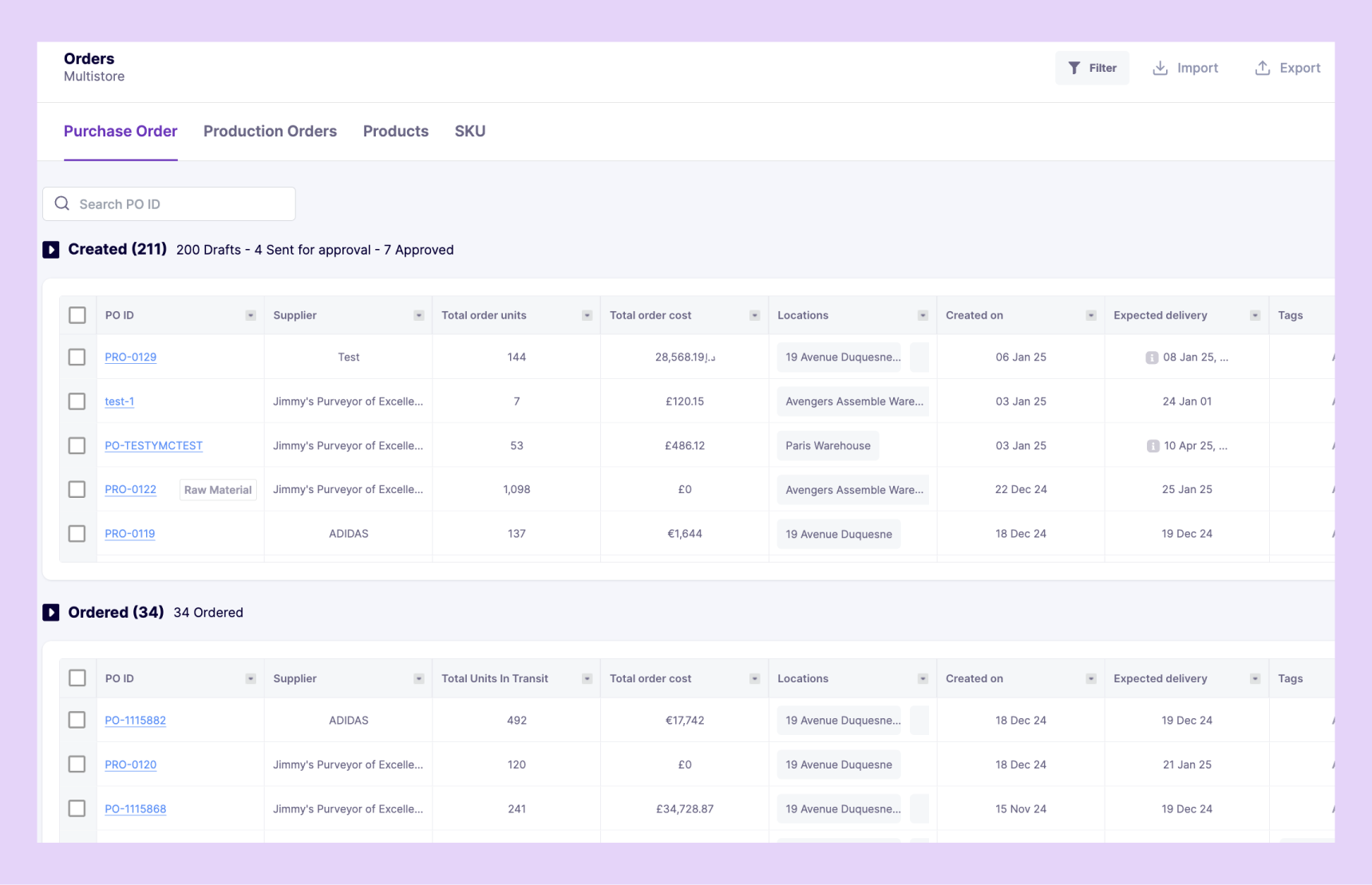
Manual tracking is prone to errors, and relying solely on human judgment can lead to overstocking since demand can fluctuate due to seasonality or shifts in trends. On the other hand, despite careful planning businesses may suffer from stockouts if they fail to factor in lead time or supply chain fluctuations. These issues impact both the bottom line and overall customer satisfaction.
Currently, Shopify’s inbuilt PO system relies solely on manual inputs. Every purchase order or purchase order update needs to be manually entered into the system. The lack of automation takes up time and is prone to errors.

These systems can streamline the process, reduce errors, and improve efficiency. By automating tasks like creating purchase orders, tracking shipments, and reconciling invoices, teams can focus on strategic initiatives such as supplier relationship management, negotiating better prices, and risk mitigation for supply chain fluctuations.
Prediko’s purchase order management provides an end-to-end solution that uses real-time sales data and analyses purchase order patterns to automate inventory replenishment. Prediko’s buying table generates live PO recommendations, which account for demand and lead times as well.
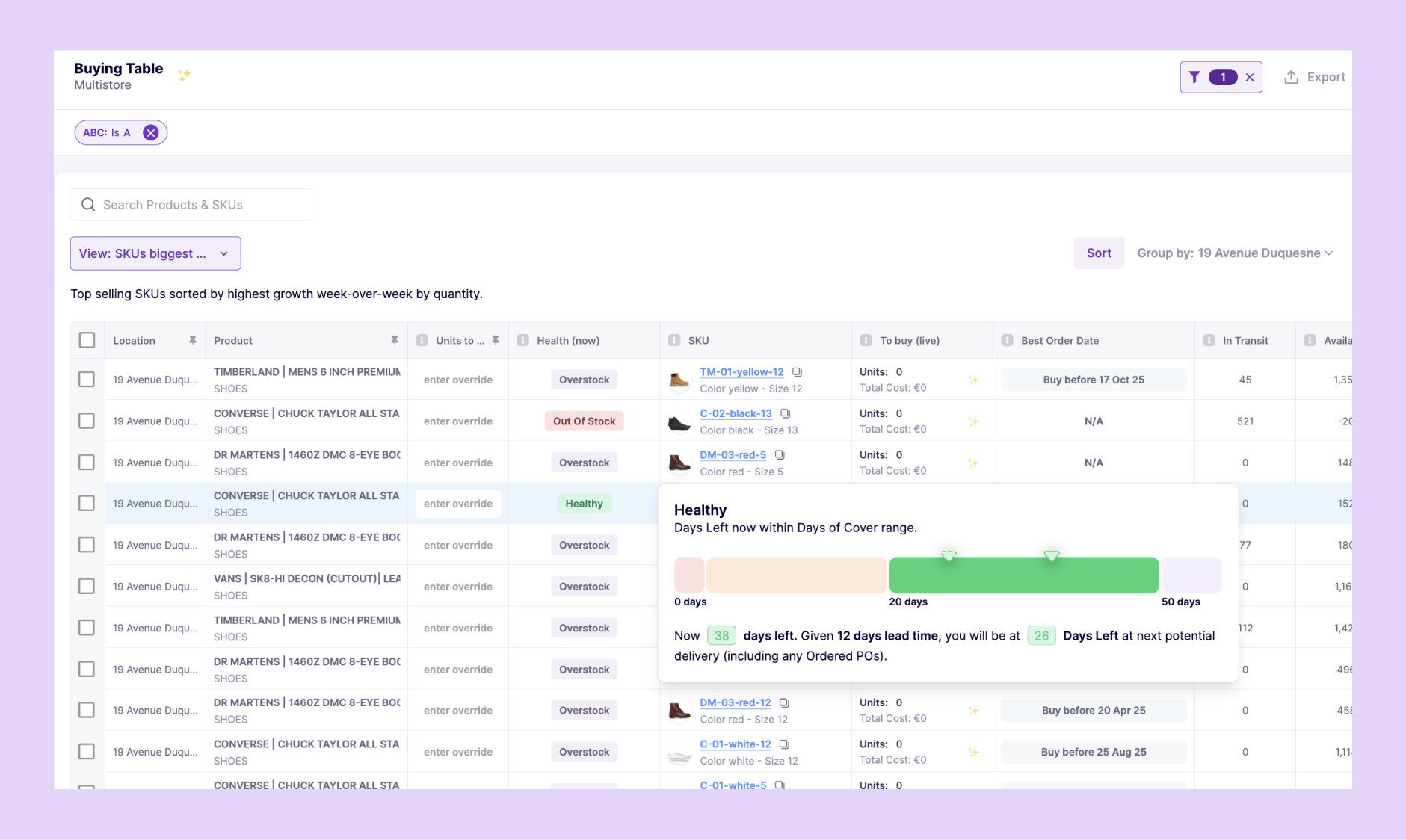
These tools not only save money they also free up time to focus on strategic initiatives like supplier relationship management, negotiation, and customer service. ]
5. Demand Forecasting
Accurate demand forecasting is crucial for businesses to optimize inventory levels, allocate resources efficiently, and meet customer demand. By adopting a data-driven approach, businesses can gain valuable insights into historical sales data, customer behavior, and seasonal trends.
A key aspect of effective demand forecasting is identifying the right forecasting method. Whether demand is smooth, lumpy, intermittent, or erratic, selecting the appropriate model is essential. Incorporating machine learning techniques, such as predictive modeling, can further enhance forecast accuracy.
Technical expertise is necessary for implementing and fine-tuning these models. Rather than invest in custom technology, businesses should focus their resources on their core competencies. By leveraging AI-powered demand forecasting tools, teams can automate data collection, processing, and analysis, and businesses can make data-driven decisions to improve efficiency, reduce costs, and enhance customer satisfaction.
Inventory reporting helps businesses track key metrics and analyze historical data. Using reports businesses can gain valuable insights into demand patterns, sales trends, and customer behavior.
In an industry where trends and seasonality can significantly impact demand, accurate and timely reporting is essential to enable teams to predict and respond to changes in real time.
Shopify offers basic inventory reporting features, including average inventory sold per day, percent of inventory sold, ABC analysis, sell-through rates, and inventory snapshots. While these metrics provide some visibility into inventory levels and sales performance, they require manual analysis and interpretation.
To gain deeper insights and make informed decisions, businesses need more advanced analytics tools. Visualizing data through charts and graphs can help identify trends, anomalies, and opportunities for improvement. For example, a sales performance report that compares actual revenue to set goals can provide valuable insights into product performance and marketing effectiveness.
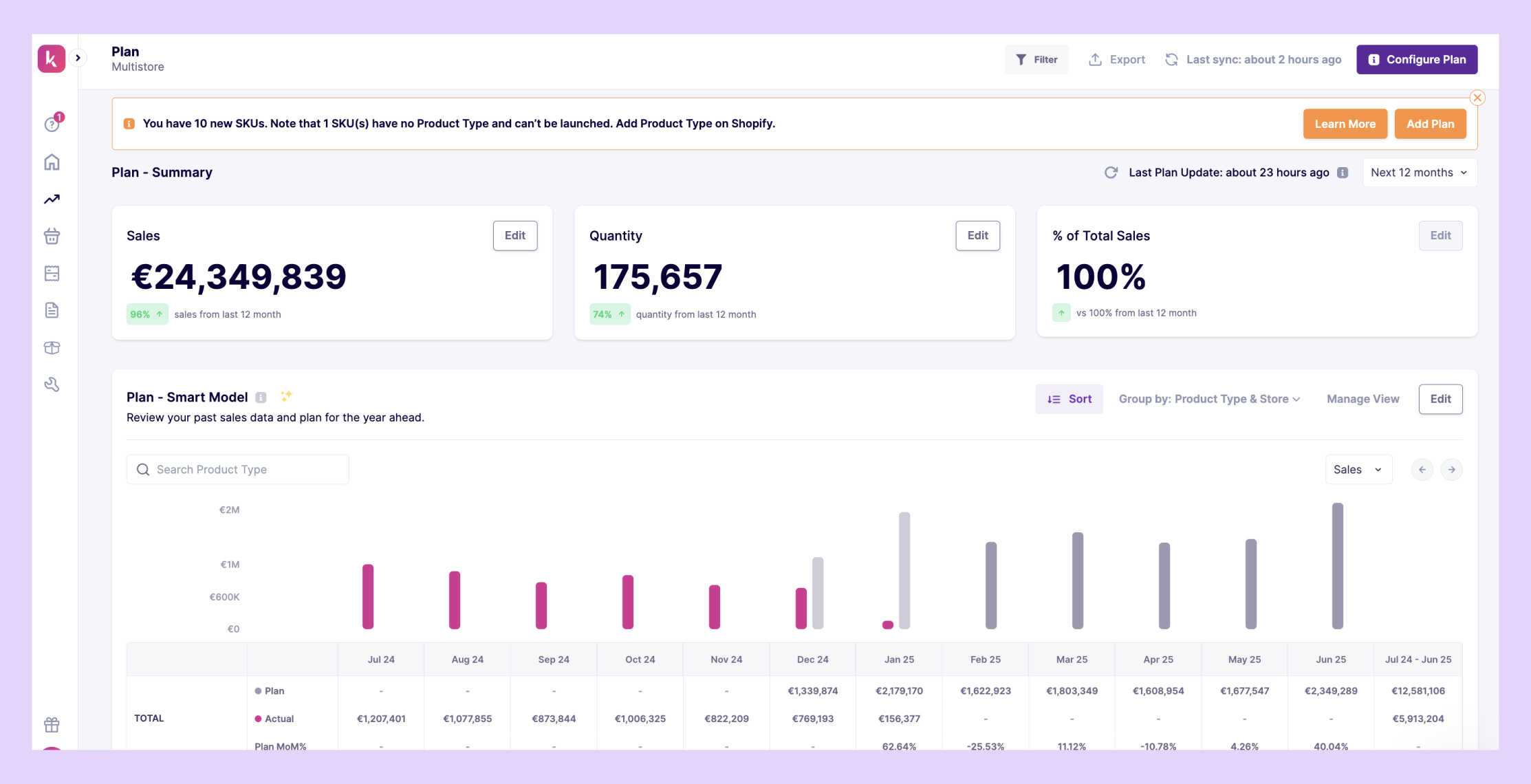
Similarly, analyzing historical sales data can help predict future demand and optimize inventory levels. By leveraging advanced analytics tools, businesses can automate data analysis, identify trends to improve inventory management, reduce costs, and enhance customer satisfaction.
While an excellent platform for launching a DTC brand, Shopify encounters limitations when scaling inventory management.
At its core, Shopify struggles to handle the complexities of large-scale inventory, encompassing a multitude of SKUs and diverse sales channels. Relying solely on Shopify or manual oversight becomes increasingly challenging as your business grows. These issues trigger a cascade of challenges:
1. Overstock and dead stock
Shopify’s inability to create product bundles hampers efforts to move slow-moving inventory. Identifying and addressing dead stock becomes a time-consuming challenge without granular data on product performance. This can lead to tied-up capital and wasted storage space.
2. Managing returns and exchanges
Efficiently processing returns and exchanges requires real-time data and quick adjustments. Shopify’s inventory management features often fall short. They have a simplistic approach, leading to delays, errors, and increased operational costs.
3. Addressing stockouts
Accurately predicting demand is crucial for preventing stockouts, but Shopify’s limited data analytics capabilities make this difficult.
- Shopify lacks comprehensive inventory visibility, especially regarding costs and pricing
- Integrating data from multiple sources can be challenging due to slow and error-prone processes.
- Shopify reports on inventory quantities with metrics like average inventory sold per day and product sell-through rate. This provides a surficial view that doesn’t help businesses account for demand fluctuations and address them.
Consequently, businesses may struggle to determine optimal safety stock quantities, facing frequent stockouts. This leads to lost sales and customer dissatisfaction. Optimize supply chain, diversify suppliers to mitigate risks, and conduct stringent stocktakes to navigatw this issue, but it doesn't address the root cause- inaccurate forecasting of demand.
4. Backorder management
Effectively managing backorders requires precise reorder points and timely communication with customers. Shopify's limitations in data analysis and automation hinder the ability to set accurate reorder points and efficiently process backorders.
5. Inventory shrinkage
Manual cycle counting is time-consuming and prone to errors. Shopify lacks advanced inventory tracking features like barcode scanning, making it difficult to accurately measure and reduce inventory shrinkage.
Inventory management for Shopify goes beyond recording available inventory and detailing variants for a product. Effective inventory management can have a wide range of impacts from improved efficiency, profitability, and better business planning. All of these are achievable with the right inventory management practices. Here are some of the most popular ones:
1. Regular stock audits and stock takes
Maintaining accurate inventory records is fundamental to effective management. Regular stock audits and physical stock takes help identify discrepancies between recorded and actual stock levels. By pinpointing these inconsistencies, businesses can take corrective actions, reduce losses due to shrinkage, and ensure that customer demand is met in time.
2. Managing routing and reorder points
Establishing clear routing and reorder points is crucial for preventing stockouts and overstocks. By defining when and how much to reorder, businesses can optimize inventory levels, reduce carrying costs, and improve cash flow. Leveraging data analytics to inform these decisions can enhance accuracy and efficiency.
3. Using barcodes and scanners for accuracy
Implementing barcode scanning technology can significantly improve inventory accuracy and efficiency. By assigning unique barcodes to each product, businesses can streamline the receiving, putaway, picking, and shipping processes. Real-time data capture minimizes human error and provides up-to-date inventory visibility.
Effectively managing inventory requires selecting the right strategy to optimize stock levels, reduce costs, and enhance customer satisfaction. Here's a breakdown of some key inventory management techniques commonly utilized in eCommerce:
1. Just-in-Time (JIT) Inventory
Concept: The core principle of JIT is to minimize inventory holding costs by receiving products only when they are needed for production or sale. This approach ensures fresh inventory while maximizing storage space and reducing carrying costs.
Ideal for: Industries with high product turnover, short lead times, and predictable demand. For example, fast-fashion retailers can benefit from JIT to avoid holding onto outdated styles.
Example: A clothing company utilizes JIT to ensure they have the latest seasonal trends in stock, minimizing the risk of holding onto unsold items from previous seasons.
2. First-In, First-Out (FIFO)
Concept: This inventory management technique assumes that the first products received are the first ones sold. FIFO ensures older inventory is sold first, minimizing the risk of obsolescence or product deterioration.
Ideal for: Industries with perishable goods or products with expiration dates, such as food and beverage companies or pharmaceutical suppliers.
Example: A grocery store utilizes FIFO to ensure older produce is sold before fresh deliveries arrive, minimizing spoilage and waste.
3. Last-In, First-Out (LIFO)
Concept: LIFO assumes the most recently received products are sold first. This method can be advantageous in times of inflation, as the cost of recently purchased goods reflects current market prices. However, it can also lead to discrepancies when reporting inventory value for tax purposes.
Ideal for: Industries experiencing price fluctuations, such as construction materials or commodities with volatile markets.
Example: A lumberyard utilizes LIFO to sell newer stock purchased at higher prices first, potentially lowering their overall tax burden.
4. Safety Stock
Concept: Maintaining a buffer of additional inventory beyond the expected demand helps mitigate risks associated with stockouts due to unexpected surges in demand or unforeseen supply chain disruptions. While this may need additional storage space and increased costs, it does safeguard against unpredictable problems when it comes to suppliers.
Ideal for: Industries with unpredictable demand or products with long lead times. This can be particularly relevant for seasonal businesses or those reliant on overseas suppliers.
Example: An online toy store maintains a safe stock of popular items during the holiday season to fulfill unexpected demand spikes and avoid stockouts.
5. Dropshipping
Concept: The seller doesn't hold any physical inventory in this model. Orders are forwarded directly to a third-party supplier responsible for storage, packaging, and shipping the product to the customer. while dropshipping comes with its own benefits, it leads to reduced quality control.
Ideal for: Businesses with limited capital or those testing new product lines without upfront investment in inventory. Dropshipping offers a low-risk entry point but may yield lower profit margins due to supplier markups.
Example: A startup clothing brand utilizes dropshipping to launch its initial product line without committing to large inventory purchases.
6. Economic Order Quantity (EOQ)
Concept: EOQ is a mathematical formula that helps determine the optimal order quantity to minimize total inventory costs. It considers factors like holding costs, ordering costs, and demand to calculate the most cost-effective amount to order at a time. This is one of the most profitable methods as it is customized to the business model and accounts for various factors. However, a business needs software infrastructure that provides accurate data to implement this method.
Ideal for: Businesses with predictable demand patterns and stable supplier relationships. EOQ can help optimize ordering frequency and minimize storage costs.
Example: An office supply store utilizes EOQ to calculate the most cost-effective quantity of printer cartridges to order based on historical demand and supplier discounts for bulk purchases.
1. Inventory turnover
Understanding and optimizing inventory turnover is pivotal for business success.
By calculating the inventory turnover ratio, businesses can gauge the efficiency of their inventory management. A high turnover ratio generally indicates strong sales and efficient inventory utilization, while a low ratio might signal excess stock or slow-moving items.
To enhance inventory turnover, strategies such as implementing targeted promotions, offering discounts on slow-moving items, and effectively managing product lifecycles can be employed. By closely monitoring product performance and adjusting inventory levels accordingly, businesses can free up capital tied up in inventory and improve overall profitability.
2. Inventory optimization techniques
Several advanced techniques can help optimize inventory levels and reduce costs. Economic Order Quantity (EOQ) analysis determines the most cost-effective order quantity by considering factors like ordering costs and holding costs. Safety stock optimization, often employing statistical models, helps balance the risk of stockouts against excess inventory.
ABC analysis categorizes inventory items based on their value and usage, enabling businesses to focus on managing high-value items more closely. By applying these techniques, businesses can achieve significant cost savings and improve inventory efficiency.
3. Supply chain collaboration
Building strong relationships with suppliers and fostering collaborative partnerships can yield substantial benefits. Vendor Managed Inventory (VMI) empowers suppliers to manage inventory levels based on point-of-sale data, reducing the burden on the retailer.
Collaborative Planning, Forecasting, and Replenishment (CPFR) involves sharing sales forecasts and crucial data with suppliers to improve visibility and responsiveness. Effective supplier relationship management is crucial for ensuring timely deliveries, maintaining product quality, and improving supply chain management.
4. Inventory visibility and control
Achieving real-time visibility into inventory counts is essential for efficient operations. RFID technology offers a robust solution for tracking product movement throughout the supply chain. Warehouse management software (WMS) provides comprehensive control over inventory storage, picking, packing, and shipping processes.
By implementing key performance indicators (KPIs) to measure inventory performance, businesses can identify areas for improvement and make data-driven decisions.
5. Risk management and mitigation
The supply chain is subject to various disruptions, including natural disasters, economic fluctuations, and geopolitical events. Developing comprehensive contingency plans, such as alternative sourcing options and disaster recovery procedures, is crucial for mitigating risks.
Additionally, investing in insurance coverage can protect against financial losses due to unforeseen circumstances. Implementing robust security measures is essential to safeguard inventory from theft and damage.
We Are Jolies, a French lingerie brand, started facing inventory headaches as they expanded into new categories. Stockouts, overstocking, and manual coordination across international warehouses were slowing them down.
That’s when they turned to Prediko, that helped them
1. Automate restocking
Gaëlle and her team started using Prediko to automate demand planning and restocking across all their locations. Setup took minutes, thanks to a smooth onboarding process led by Prediko’s product team.
Once inside the platform, they gained a complete view of sales, inventory, and purchase orders, centralized in one place.
Most importantly, Prediko’s AI-driven forecasting helped them anticipate sales patterns and trigger restock alerts that aligned with their supplier lead times and MOQs.
2. Reduced overstocks
Before Prediko, much of their inventory planning relied on intuition.
That often meant betting big on new products without enough data, leading to excess stock that sat unsold. Meanwhile, hero SKUs would stock out unexpectedly.
Now, their inventory strategy is driven by real-time sales data and product-level forecasting. Prediko helps the team plan smarter, reduce over-ordering, and keep their bestselling items consistently available.
The Results

Since implementing Prediko, We Are Jolies has seen clear improvements in how they manage stock
- Accurate restocking powered by AI forecasting
- Fewer stockouts (60% decrease), especially for fast-moving SKUs
- Less dead stock, resulting in better cash flow (13% increase in revenue)
- Centralized visibility across warehouses and channels
Today, Gaëlle and her team no longer rely on spreadsheets and guesswork. They plan with precision and scale with confidence, knowing Prediko has their back.
Read the full case study here.
One of the biggest benefits of using Shopify is the strong ecosystem of Shopify Apps. Whether you want advanced billing systems or AI-powered product suggestions and bundling software, Shopify has it all. It's counter-productive to subscribe to software that does not integrate with your stack. Strong integrations are crucial for a streamlined workflow. Look for inventory management apps that integrate with your accounting, shipping, and order management systems. This will help optimize operations as your team won't have to tackle multiple tools and tabs at the same time.
Even with substantial manpower and resources dedicated to manual tracking, achieving the same level of accuracy and efficiency as the right inventory management software is virtually impossible.
Maximize the benefits of inventory management software, look for platforms that offer the following core features:
Real-time inventory updates
Accurate and up-to-date inventory data is paramount for effective management. Seek software that provides real-time visibility into stocks across all channels, ensuring consistency and preventing stockouts or overstocks.
Multi-location inventory management
For businesses with warehouses or fulfillment centers at multiple locations, software capable of managing inventory across different locations is crucial. Real-time tracking of stocks and transfers between locations is essential for optimizing operations and reducing costs.
Read Our Complete Guide to Multi-Location Inventory in Shopify
Demand forecasting
Predictive analytics is vital for aligning inventory with customer demand. Look for an inventory management system that offers robust forecasting capabilities, utilizing historical sales data, market trends, and other relevant factors to optimize stock levels and minimize lost sales.
Purchase order management
Efficient purchase order management is essential for maintaining optimal inventory levels. Choose an inventory management system that has automated purchase order creation, helps track order status, and integrates with suppliers for seamless collaboration.
Also read: Best Purchase Order Management Shopify Apps. Learn Why Prediko is No.1
Barcode scanning and serial number tracking
Barcode scanning and serial number tracking enhance inventory accuracy and traceability. Software that supports these features enables efficient stocktaking and reduces human error. Not only that it helps counter the effects of shrinkage and makes categorization easier as well.
Integration with other Shopify apps
Prediko goes beyond just forecasting demand. It translates those predictions into actionable insights for smarter inventory planning. The software suggests optimal reorder points based on predicted demand and lead times, ensuring you have the right amount of stock at the right time.
Scalability and customization
As business grows, your inventory management needs will evolve. Pricing structures are often a good indicator of scalability.
If the inventory management software offers pricing based on the number of seats it may not be suitable for growing teams. If the pricing is based on sales volume, the system might not be able to scale with your business. Choose software that can adapt to your changing requirements. Also, look for customization options to fit your specific needs.
If you have multiple vendors and warehouses, whether you own order fulfillment or not- your software features should support your needs.
By leveraging the power of AI and advanced data analytics, Prediko empowers DTC brands to take their Shopify inventory management to the next level.
See Prediko in action:



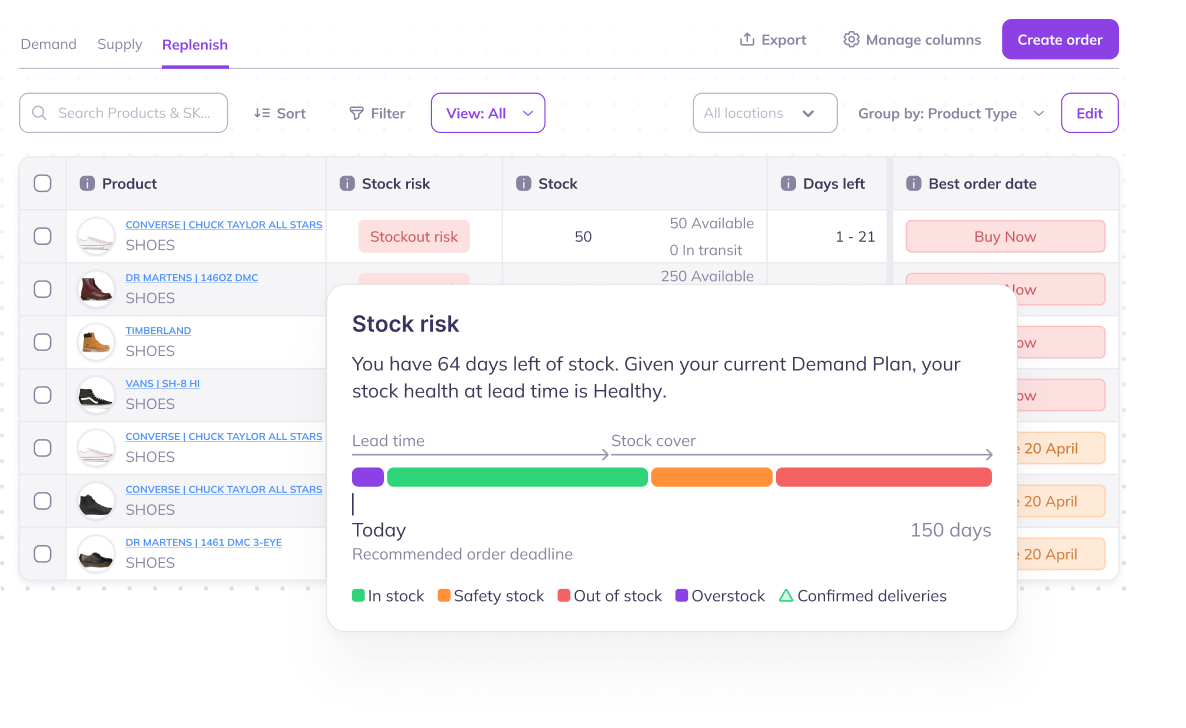



.avif)
